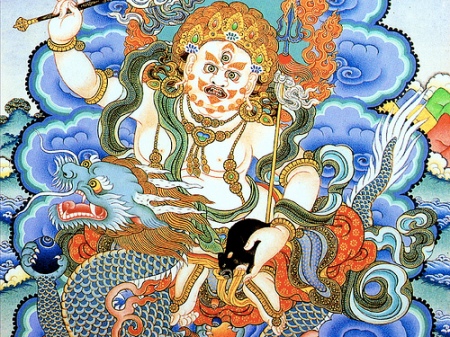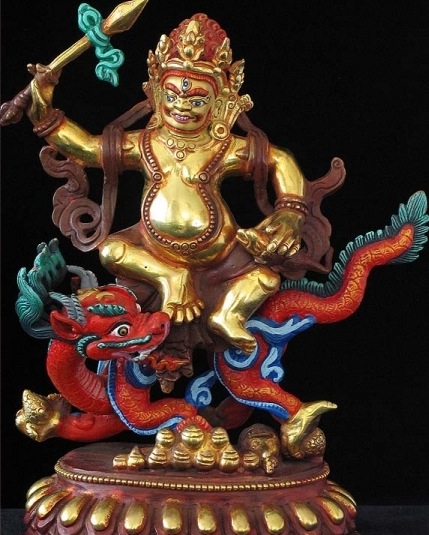White Dzambhala, an emanation of Avalokiteshvara (or Guanyin Bodhisattva), is also known as the “White Treasure Lord”. According to legend, White Dzambhala is born from the right eye ( to be precise, the tear ) of Avalokitesvara Bodhisattva.

White Dzambhala has one face, three rounded eyes and two hands, holding in the right is a precious cudgel and in the left a treasure-emitting mongoose. A trident tipped katvanga staff rests against his left shoulder. He is wrathful in appearance with his hair, red & yellow in color, fizzing upwards like flames; adorned with jewel ornaments, a precious headdress and silks of various colors. He rides on the back of a jade-colored dragon.
His Mantra: Om Padma Trotha Arya Jambhala Siddhaya Hum Phat
Cultivating the White Dzambhala Practice enables the eradication of poverty and illnesses. It can eliminates sins and karmic hindrances, enhance one’s positive karmic affinities and wealth. This is an excellent cultivation for the financially impoverished. The Buddhist disciple should cultivates this with the compassion of Guanyin Bodhisattva, practices formless charity and care for the suffering sentient beings; leading to spiritual accomplishment and the fulfillment of all wishes.

When cultivating the “Dragon-ridding White Dzambhala Practice”, we can also pray that he will lead us to hidden treasures. In the olden days, Tibetan Tantric masters placed their precious teachings in caves. These teachings were sealed in the four elements of “earth, water, fire and wind”. One needs to employ very special methods to retrieve these Dharma treasures. One must also know the location of the caves where these ancestry masters had practiced in seclusion. We may pray to the “Dragon-ridding White Dzambhala”, so that he will bring us to these caves where the treasures were hidden.

One could offer spheric dessert made from 3 “white” ( milk, yoghurt, flour ) & 3 “sweet” ( white sugar, rock sugar, honey ) to White Dzambhala.